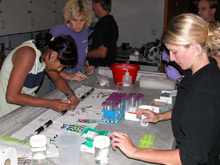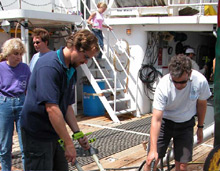
Members of the Deep Scope science party assist Sharmishtha in quickly processing the sediment profile peepers. Each person was assigned a dedicated workstation to facilitate the process. Click image for larger view.
![]() Click here to see a condensed version of the peeper recovery and sampling process.
Click here to see a condensed version of the peeper recovery and sampling process.
Sediment Profile Peepers: A Stowaway's Tale
August 14, 2004
Sharmishtha Dattagupta
Graduate Student
Department of Biology
Pennsylvania State University
Oceanography is a multidisciplinary and very expensive science. Staging research cruises at sea involves large vessels, submersibles, reliable technology, good weather – and a dash of good luck. I managed to have all of these, except for the latter.
You see, I am a stowaway on this expedition. Not part of the original Operation Deep Scope science party, I find myself here by the good graces of co-chief scientists Edie Widder and Tammy Frank. I suppose they took pity on me after hearing of my string of misfortunes. Let me share a little background.
For five years, I have been studying deep-sea organisms for my doctoral thesis. As part of this effort, I decided about two years ago to measure the chemistry of porewater (water contained in sediments) surrounding tubeworm colonies. I also decided to use a technique first used in the 1970s, called “peepers.” The basic principle behind this method is that bags of water submerged in sediment (left untouched for several weeks) will assume the chemistry of the water surrounding them in the sediment. By analyzing the chemistry of the water inside the bags, you can “peep” into the chemistry of the sediment.
There were two challenges in adapting this technology to the deep sea. First, I'd need a one-armed submarine to manipulate my peepers at depths up to 600 m. Second, I needed a way to seal the bags of water after they were collected, or the samples would be compromised during recovery.

Seconds after the peepers reached the surface they were removed from the submersible basket and rinsed with seawater. Click image for larger view.
Several prototypes (and many improvements) later, we built 12 seemingly functional peepers. In July, we deployed all 12 peepers with relative ease, and waited at sea for three weeks while they "incubated" at the bottom of the ocean. The day before we were scheduled to retrieve them, the submarine had a mechanical failure. We had to return to port without the peepers. I had ventured out to sea with high hopes of collecting a large body of data for my thesis. Now, here I was, after two years of hard work, with no data – and 12 peepers sitting in the mud at the bottom of the ocean!
Immediately, my thesis advisor immediately went to work, trying to find me a spot on another cruise to the Gulf of Mexico. That is how I came to stow away aboard Operation Deep Scope. (Frequently, this community lends a helping hand to one another.) I waited patiently for my turn to visit the site where my peepers were sitting. The day finally came, and – you guessed it – a major hurricane blew through and it was too dangerous to dive. Two more days passed; I was seasick and had given up all hope. At last, the seas calmed and we finally managed to collect all 12 peepers, with only three casualties.
With the help of several scientists and crew members, we managed to sample the peepers onboard in very short order. By the time we processed the last one, it was as if the team had been doing it for years.
I still have about six months of analysis left to see whether these data tell me anything new and interesting. I hope to determine whether the tubeworms I am studying influence the porewater chemistry surrounding them, which would be a very cool finding. I'm grateful to Deep Scope for changing my luck and putting me back on the research path.
(top)























